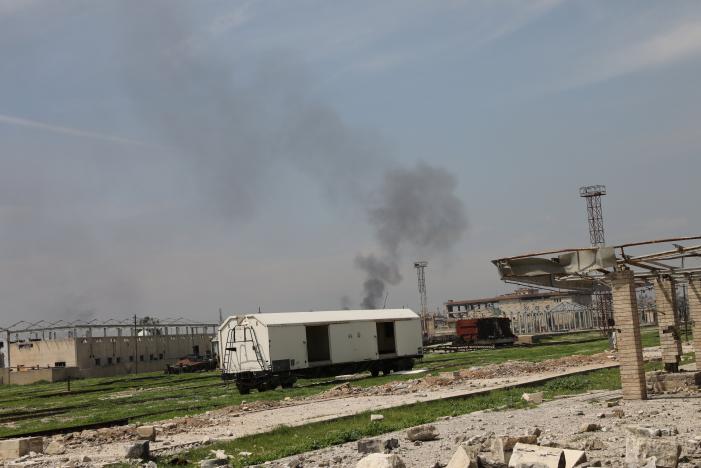Lone freight train stranded at Mosul’s wrecked rail hub

Smoke rises up from buildings as train cars are seen in the railway station in Mosul, Iraq, April 5, 2017. Picture taken April 5, 2017. REUTERS/Andres Martinez Casares

In one corner of the wrecked site, Iraqi soldiers take cover from sniper fire behind piles of sand – the only activity in what is left of a station planned as part of a historic German-Ottoman rail project to link Baghdad with Berlin.
Old pictures show yellow taxis and buses bringing passengers to the two-storey station, built in 1938, with its two wings stretching along the track.
The roof is now collapsed, the main building hit in the battle raging for weeks between advancing Iraqi forces and Islamic State militants holed up in the nearby Old City.
Just one small structure survives nearby marked with an Iraqi railway emblem. The soldiers do their best to ignore the stench from a dead body lying inside.
Further along the track, Iraqi federal police check storage sheds for booby traps left by the Sunni Muslim militants, known to their opponents as “Daesh”.
HISTORIC HUB
The bombing brought a final halt to what was once a bustling transport hub.
Mosul was part of a German-Ottoman plan called Bagdadbahn to link Berlin with Baghdad and the Gulf port of Kuwait, both then part of the Ottoman empire – a scheme that rivaled the scale of the Orient Express.
But the collapse of that empire following World War One interrupted the project and the tracks between Istanbul and Baghdad only got completed around 1940.
Mosul later turned into a gateway for cargo and passenger trains from Syria and Turkey to Baghdad and Basra in the south.
Traffic thinned during the 1990s when Iraq was under U.N. sanctions after Saddam Hussein’s Kuwait invasion, as little was spent on maintenance.
Since 2012 the rail services from Mosul had stopped due to deteriorating security situation. Authorities were preparing to restart regular trains to Turkey and Baghdad when lslamic State arrived in June 2014.
During the fight-back against the militants, that started building up in October, Iraqi forces used helicopters and artillery to support ground forces.
Not every strike hit its militant target. Entire blocks were destroyed in western Mosul.
“Air strikes struck every block. There were no Islamic State fighters or whatever,” said Aly Ibrahim Eissa who fled after air strikes in his street. “A whole block was destroyed from top to bottom by coalition planes.”
The city’s airport was also reduced to rubble in the fighting. The militants blew up the runway, and destroyed buildings and infrastructure as they retreated, according to residents.
“They removed most tracks to build rockets or other weapons, “said Abdulllah Ahmed, a Mosul engineer. “There were no trains under Daesh.”
